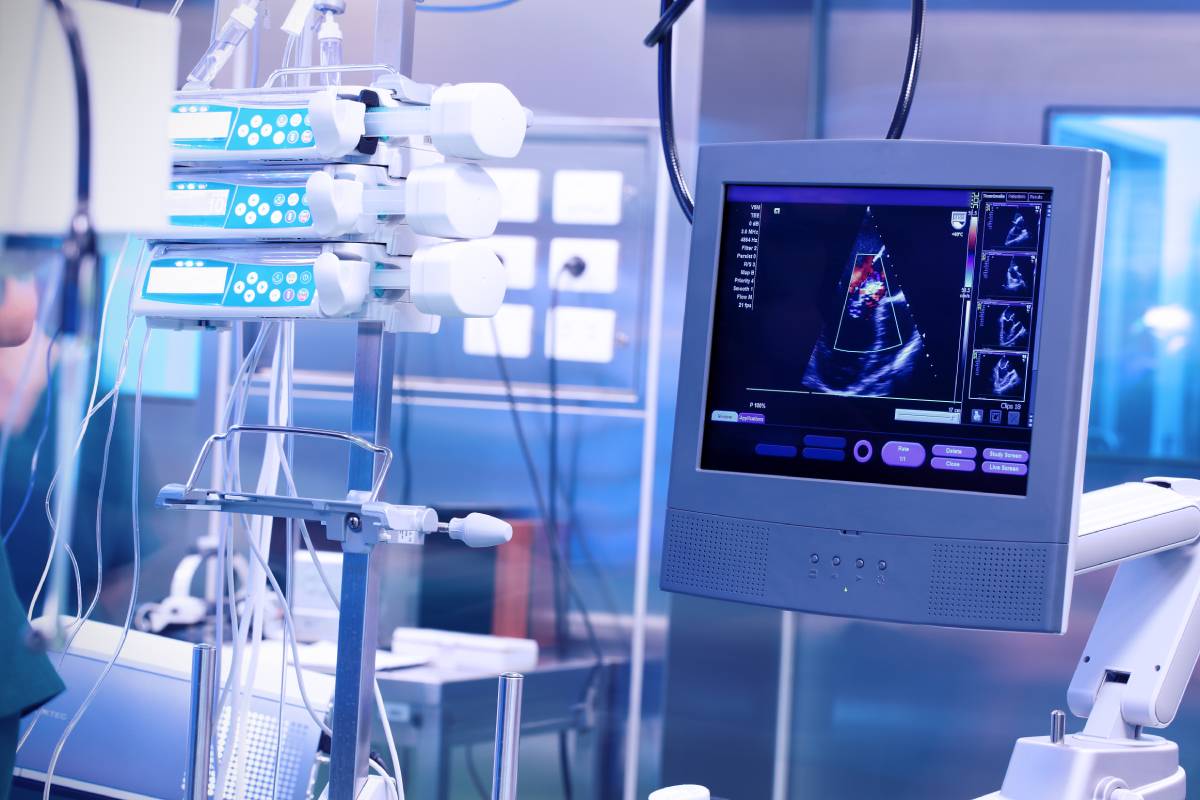Ultrasound technology harnesses high-frequency sound waves beyond the hearing abilities of humans. Ultrasonography operates with probes which generate sound waves and capture what is reflected, which is then transformed into an image on a screen (Li et al., 2020). Portable ultrasound devices have been increasingly integrated into the operating room (OR) and have become a vital tool in modern medicine. Often referred to as point-of-care ultrasound (POCUS), this technology offers real-time imaging capabilities. In the operating room, this allows surgeons to make decisions during procedures quickly and with more information.
Portable ultrasound can decrease the use of invasive procedures, including exploratory surgery, when it is unnecessary. With ultrasound, surgeons can assess the need for invasive measures more accurately (Bollard, et al., 2021). Portable ultrasound devices also provide real-time feedback in the OR. This enables surgeons to monitor changes and adapt their approach during complex surgery.
Various surgical disciplines benefit from the incorporation of portable ultrasound in the OR. Some surgeries that utilize portable ultrasound include abdominal surgeries. For example, with portable ultrasound in liver or kidney surgeries, surgeons assess blood flow, identify anatomical variations, and detect abnormalities. The POCUS is especially important in detecting free fluid around the abdominal structures, which poses a surgical emergency (Abu-Zidan & Cevik, 2018). Even in plastic surgery, the portable ultrasound has had unique uses (Safran et al., 2018). Ultrasound can be used to visualize anatomy and offer an energy source for procedures. For example, in hand surgeries, POCUS allows surgeons to localize foreign bodies and guide procedures (Bollard, et al., 2021).
Portable ultrasound is not only used on the surgeon’s side in the OR. Anesthesiologists use various forms of ultrasound during surgical procedures to monitor patients. For example, they may use transesophageal echocardiography to manage and watch cardiac and non-cardiac patients in the surgical setting. Cardiac ultrasound can detect pulmonary embolism and cardiac tamponade and guide immediate treatment (Kalagara, et al., 2022). Anesthesiologists may also complete ultrasounds of the lung to diagnose hypoxia, confirm proper placement of an endotracheal tube, or locate the cricothyroid membrane when securing an airway. Anesthesia may also do a gastric ultrasound to help understand the gastric contents of a patient. However, this type of ultrasound is more controversial (De Marchi & Massimiliano, 2017). For patients who have challenging airways, need emergency surgery, or have certain comorbidities, gastric ultrasound may help assess aspiration risk (Li et al., 2020).
Ultrasound is becoming increasingly integrated in medical education. It is critical that medical students, residents, fellows, and physicians receive proper training on POCUS. An ultrasound’s effectiveness is very dependent on the operator’s skill and their ability to read the image produced by the ultrasound (Li et al., 2020). In anesthesia, where POCUS is of great use in the operating room, there is no standardized education. However, more groups have started organizing education series on this topic and creating frameworks for POCUS education (Li et al., 2020).
In conclusion, the incorporation of portable ultrasound into the operating room is revolutionizing surgery by enhancing precision, reducing invasiveness, and enabling real-time assessment of anatomical structures and surgical procedures. These devices have become indispensable for surgeons across various medical specialties and for anesthesiologists. As ultrasound technology advances, their prevalence in the operating room is bound to grow. It is vital that research continues to assess best practices for utilizing this transformative technology.
References
1) Abu-Zidan, Fikri M, and Arif Alper Cevik. “Diagnostic point-of-care ultrasound (POCUS) for gastrointestinal pathology: state of the art from basics to advanced.” World journal of emergency surgery : WJES vol. 13 47. 15 Oct. 2018, doi:10.1186/s13017-018-0209-y
2) Bollard, Stephanie Marie et al. “The Use of Point of Care Ultrasound in Hand Surgery.” The Journal of hand surgery vol. 46,7 (2021): 602-607. doi:10.1016/j.jhsa.2021.02.004
3) De Marchi, Lorenzo, and Massimiliano Meineri. “POCUS in perioperative medicine: a North American perspective.” Critical ultrasound journal vol. 9,1 19. 9 Oct. 2017, doi:10.1186/s13089-017-0075-y
4) Kalagara, Hari et al. “Point-of-Care Ultrasound (POCUS) for the Cardiothoracic Anesthesiologist.” Journal of cardiothoracic and vascular anesthesia vol. 36,4 (2022): 1132-1147. doi:10.1053/j.jvca.2021.01.018
5) Li, Linda et al. “Perioperative Point of Care Ultrasound (POCUS) for Anesthesiologists: an Overview.” Current pain and headache reports vol. 24,5 20. 21 Mar. 2020, doi:10.1007/s11916-020-0847-0
6) Safran, Tyler et al. “The role of ultrasound technology in plastic surgery.” Journal of plastic, reconstructive & aesthetic surgery : JPRAS vol. 71,3 (2018): 416-424. doi:10.1016/j.bjps.2017.08.031

